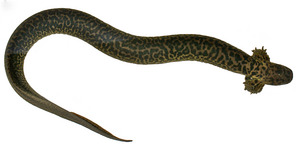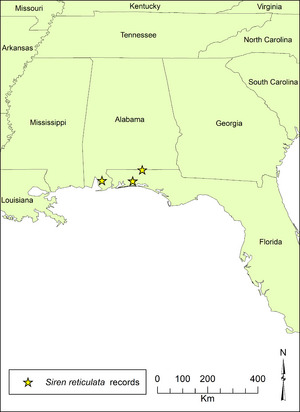Leopard siren facts for kids
Quick facts for kids Leopard siren |
|
|---|---|
 |
|
| Scientific classification | |
| Genus: |
Siren
|
| Species: |
reticulata
|
 |
|
The reticulated siren (Siren reticulata), also called the leopard eel, is a type of salamander that lives in water. It is found only in the southeastern United States. Scientists officially described this hidden salamander in 2018. It is known from only a few places in southern Alabama and the Florida panhandle. This siren is one of the biggest animals in the U.S. that has been discovered and named in the last 100 years!
Contents
About the Reticulated Siren
The reticulated siren is one of the largest living salamanders in the world. It can grow up to 60 centimeters (about 2 feet) long. This makes it as big as the hellbender from the Appalachian Mountains. It is the largest amphibian in North America and the third largest salamander globally.
What Does It Look Like?
This siren has a body like an eel, which is greenish-grey. It has large gills on the outside of its head and two small front legs. Its sides and belly are a lighter yellowish-green color.
The reticulated siren is special because of its skin pattern. It has dark, leopard-like spots all over its back. This is different from other Siren species. It also has a smaller head and a longer tail compared to its relatives.
Where Does It Live?
Scientists do not know much about the life of the reticulated siren. We do know that it lives in wetlands. These wetlands are often found within the longleaf pine ecosystem.
How Was It Discovered?
The first reticulated siren known to science was found in 1970. This happened in Baldwin County, Alabama. A scientist named Robert Hughes Mount noted that it did not look like other known sirens. However, it was not officially named at that time. People sometimes called it the "leopard eel," almost like a legend.
More Sightings
In the 1990s, another scientist, John Jensen, saw many of these sirens. He reported seeing dozens of reticulated sirens and amphiumas crossing a road. This happened during a rainstorm near Florala, Alabama.
The Official Discovery
In September 2009, an American scientist named David Steen was studying snakes and turtles. He was at Eglin Air Force Base in Okaloosa County, Florida. There, he caught a single reticulated siren in a crayfish trap.
Scientists tried to find more sirens between 2009 and 2014, but they were not successful. Then, in June 2014, three more sirens were found. They were near Lake Jackson in Walton County, Florida. The reticulated siren is one of the biggest animals in the U.S. to be newly described in the last 100 years.
Naming the Species
The leopard eel was officially named Siren reticulata in December 2018. The name reticulata means "network-like" or "patchwork." This refers to the unique spotted pattern on the siren's skin. The scientists who named it also suggested "reticulated siren" as a better common name. This is because it is not a leopard and it is not an eel!
This siren is one of three living species in the Siren group. The first female specimen caught in Walton County, Florida, is very important. It measured about 39.7 centimeters (1.3 feet) long and weighed 221 grams (about half a pound). It was found in a shallow marsh with many plants.

